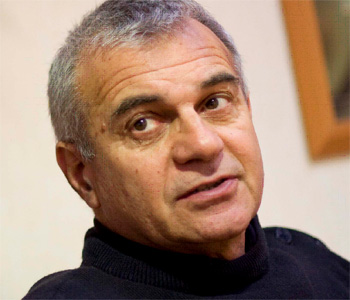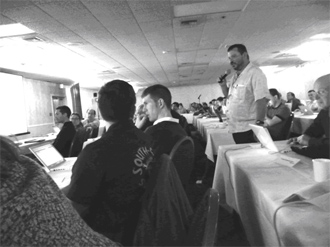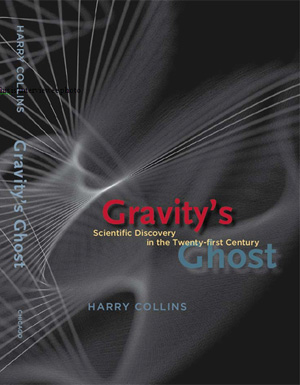
How do physicists decide that some data might constitute a discovery?
The way to find out is to watch. For 18 months I watched physicists arguing about a burst of data that turned up around the Fall Equinox of 1997 and became known as the “Equinox Event.”
What they saw was a little jump in the output that happened at the same time on both of the giant interferometers that make up LIGO –the Laser Interferometer Gravitational-Wave Observatory. Each of these interferometers has two arms at right angles that are two-and-half miles long. They are sighted around 2,000 miles apart, one in Washington State and one in Louisiana. So if they both go off together it suggests that something coming from a long way away was the cause.
But that’s only the start. Maybe the bursts were just coincidental noises on both devices. Maybe there was an earthquake or an electrical storm 1,000 miles from each. Maybe everyone got up and switched on the coffee-maker at exactly the same time when the ads came up during an exciting television program, causing a sudden glitch in the power grid.
It took 18 months for the physicists to argue out what they should say about the effect and during all this time they also knew the signal might be a fake put in deliberately to test them.
”That millions of people revere Steven Hawking’s popular books is worrying; those millions surely do not understand them, so the works of science are being treated as something holy in themselves.”
I’ve been doing this kind of work since 1972 when I was a graduate student doing my PhD.
In that year I drove 5,000 miles in an old car, a big white Ford Galaxy, up into Canada and then along Route 66 into California. All the way I was stopping off and interviewing scientists in different universities and other locations about four topics. One of those was gravitational waves.
At the time there was a controversy about whether Joseph Weber, the pioneer of the field, had actually seen the waves. By about 1975, no one believed he had seen them—though Joe Weber, who died in 2000, never changed his mind.
On my 1972 drive, and a subsequent return trip across the USA in 1975, I collected the reasons people gave for their changing views—I looked at what made them change their minds. I’m still looking at the same field of science. And those gravitational waves have still not been detected according the consensus view even though, over the years, about half-a-dozen claims to have seen them have been made.
When I started you could build a state-of-the-art gravitational wave detector in one laboratory room for a few tens of thousands of dollars. Nowadays it’s a multi-national, billion-dollar project using enormous interferometers.
In 2004 I published a 876 page book called Gravity’s Shadow, which explains how the field grew from the beginning to the early 2000s, looking at all the claims that fell by the wayside and how they were pushed aside, looking at how the field grew from a small science to a big science and the strains that were involved, and looking at the way the scientific knowledge was constructed.
This work is just the most sustained element of a program in which I try to understand the nature of knowledge by watching it being made. Thus, I have also written on parapsychology, on the development of a certain kind of laser, on certain famous historical episodes in science, such as the proof of the theory of relativity.
Gravity’s Ghost marks a new departure in that the last chapter, called the Envoi, is about the role of science in our society and where science is and ought to be going. The main part of the book is the case study of the Equinox Event written up as a detective story but that last chapter looks back on all the wonderful scientific argument we have witnessed and asks how it can be sustained given the pressures of modern life.
There are two quite different aspects of the work to which I would want to draw a reader’s attention. The first aspect is what most of the book is about; the second aspect is the role of science in the Twenty-First Century, which is discussed in the ten page Envoi toward the end.
To get the idea of the body of the book I would hope the reader would open it at page 1 and read through to the end of the first paragraph on page 2. They would find out they were going to read a scientific detective story. Here were hundreds of scientists trying to work out what to say about a possible signal. Not only did they have to work this out, but lingering in the back of their minds was the possibility that the whole thing was a fake.
So there are really two detective stories intermingled, and one of the tensions in the book is how one affected the other. Did the possibility that the signals had been deliberately injected to test the community cause them to be less assiduous in the search or not? Mostly the scientists managed to suspend their disbelief. Given this they argued fiercely about what the signal should be said to mean. Some people were badly hurt, some people got very angry. Even at the end of the 18-month process no one was sure whether what they had done was a success or a failure.
Still more puzzles about how to handle data in a case like this were generated. Even I was surprised at extent of conflicting and contradictory views that came out at the post-mortem. I believe this is an exciting story—I certainly found it fascinating and was gripped throughout the 18 months, wondering about what was going to happen. I found myself getting involved in the arguments and disagreeing with my best friends in the project. Emotions were sometimes strained. All this comes out as the story unfolds.
Though the book is written in ordinary language I think the reader will also learn a lot about the almost unbelievable science of gravitational wave detection. The big detectors have arms 2.5 miles long and seeing a gravitational wave amounts to monitoring changes in the lengths of those arms as the wave passes. The scientists look at the length of one arm as compared to the other. The change in length they need to see is around 1,000th of the diameter of a proton—in an arm two-and-half miles long!
To get the other aspect of the book I would hope the reader would flick open page 154. This is where the meat of those final ten pages begins.
I ask what science is today. I worry that it is becoming a branch of the entertainment industry or an outlet for venture capital.
But science is much more important than that because of the values it cleaves to. These values have seeped out into society and inform the way we think about political decisions, not just technical decisions.
My field, the social studies of science, is politically savvy and somewhat cynical. We have done a marvelous job of showing the ordinariness of science, and we are experts at spotting the way political and economic interests affect what counts as scientific truth. But we have done these jobs so well that we in danger of losing sight of the positive elements of an ideal science.
Indeed, the reason that social scientists are so angry with science is that it does not live up to its own ideals. It is the importance of these ideals to which I draw attention in the Envoi.
The attack on them comes from a variety of directions, some of them less than obvious. For example, that millions of people revere Steven Hawking’s popular books is worrying; those millions surely do not understand them, so the works of science are being treated as something holy in themselves. Science, as it displaces religion, is taking up the very same iconography!

”Science contains a wonderful set of values at its heart. If scientists do not understand this, then science could become just another arm of capitalism, politics, or the entertainment industry.”
There are several different ways in which I would like the book to have influence.
I would like to create a new kind of science writing—to capture the excitement of science but without making up science fairy-tales. Science is nearly always a messy and untidy business, not a matter of sudden heroic insight. But this messy and untidy business is still exciting—it is fascinating to watch opinion forming through the interplay of argument and calculation.
Related to this point, I would like the book to lead to a better relationship between natural science and social science.
My own relations with the scientists who I have followed and interacted with for 45 years are very good. Indeed, I have just been asked to give an after-dinner address to a major international meeting of the group. But it would be nice if there were more relationships of this kind.
It is not only scientists’ suspicions that will have to cool, however. Social scientists will have to become more genuinely interested in the science they study. For me it is easy because I have always been fascinated by this field of physics.
Another kind of influence I would wish for the book is related to the others but it is more a matter of the general public. I would like the public to understand both the difficulty and uncertainty of reaching scientific conclusions—but also the enormous skill and virtuosity that goes into them.
The trick is to understand that the best possible conclusion may not turn out to be the right conclusion in the very long term. Only a seer can know the long term before it unfolds. But science is still a much better way to try to work out what is true than anything else we have.
The final influence I would like for the book relates to the Envoi. I would like it to become widely understand by both scientists and ordinary people that science contains a wonderful set of values at its heart. If scientists do not understand this, then science could become just another arm of capitalism, politics, or the entertainment industry. If ordinary people do not understand this, we might find ourselves back in a cultural condition we thought we have long escaped.


Harry Collins is Distinguished Research Professor of Sociology and Director of the Centre for the Study of Knowledge, Expertise and Science at Cardiff University. He has held visiting appointments in Brazil, China, United States, Germany, etc. He was awarded the 1997 Bernal prize for social studies of science and has also received the American Sociological Association’s Robert K. Merton book prize and the British Computer Society Specialist Group in Expert Systems Prize for Technical Merit. He has published sixteen books and around 150 papers. Harry Collins is continuing to research and write on gravitational wave detection, and, with support from a European Research Council Advanced Grant, on the nature of expertise and on a new technique for exploring expertise—the “Imitation Game.”